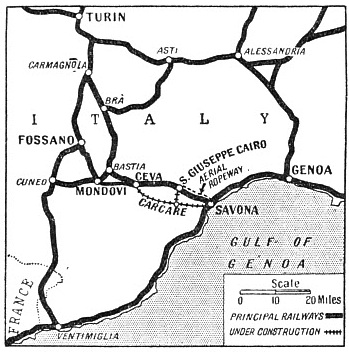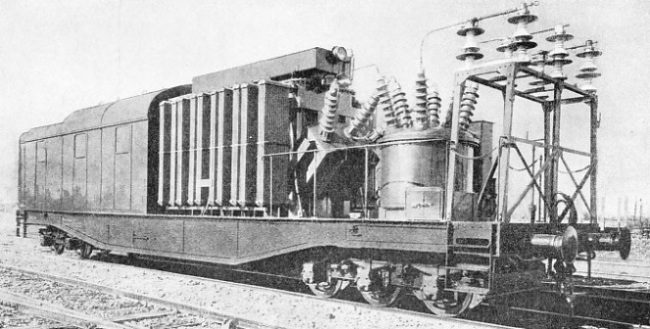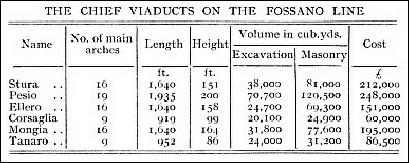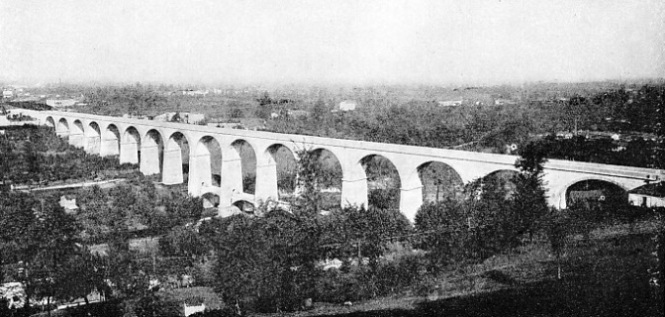
© Railway Wonders of the World 2012-


Modern Construction in Italy
Notable Features on an Important Line

THE COAL DISCHARGING PLANT at the port of Savona in the Gulf of Genoa. Communication between this port and Turin has been improved by the building of a new line between Fossano and Ceva.
ITALY is practically the only country in Europe where important new railways have been built during the last twenty years, and where new lines are at present under construction. During the ten years ending 1935, 410½ miles of line have been completed and opened for traffic. To this mileage must be added, narrow gauge lines totalling 212 miles. Further, about 380 miles of railway lines belonging to private companies have been completed during the last twelve years, or are nearing completion.
One of the new lines, the Bologna-

THE ITALIAN STATE RAILWAYS recently doubled the track from Carmagnola to Fossano, and built a new line from Fossano via Mondovi to Ceva. The recently built Fossano-
The original idea of doubling the track from Savona to Carmagnola was abandoned because of the difficulties of the route. But a line exists from Carmagnola to Fossano (on the Cuneo-
The double-
The line continues through a deep and long cutting which necessitated the excavation of 400,000 cubic yards and ascends a gradient of 1 in 170 to the station of Trinita-
Between here and Ceva the line crosses the extreme northern slopes of the Maritime Alps. The surface is different from that on the other sections. A continuous sequence of hills intersected by valleys or openings is found, and the soil is composed partly of sand and marl, partly of conglomerates of different nature.
Numerous gradients and curves, the latter reduced in radius to 875 yards, and several tunnels, characterize this stretch.
After leaving the station of Mondovi the line crosses the Ellero torrent by a viaduct 1,640 ft long, having sixteen arches. Passing over several roads, the line then enters the first tunnel, 730 yards in length. Several valleys and torrents are crossed by minor viaducts and, beyond the Rio Bianco, the line enters a tunnel to negotiate the double mountain range which divides the Ellero Valley from the Corsaglia Valley, the distance being two and a half miles. The peculiar conformation of the mountains made it possible to build two separate tunnels instead of one.
The first tunnel has a length of 1,231 yards. Beyond a narrow opening is the second tunnel, 3,065 yards long. On emerging from this tunnel the line reaches its highest altitude at 1,491 ft. From here onwards the track descends over a long embankment with a down gradient of 1 in 175 as far as the river Corsaglia, which is crossed by a viaduct 919 ft long, and having nine spans. Embankments and cuttings now alternate. The Mongia torrent is crossed by a viaduct of 1,640 ft, with sixteen arches, and, after passing through two tunnels of 1,418 and 475 yards respectively, the line runs over the Tanaro River on a viaduct of nine arches, and 952 ft long. Shortly afterwards the newly reconstructed station of Ceva is reached.

A MOBILE SUB-
The extent to which the modern idea of railway construction has been adopted on the Fossano line is apparent from the large number of viaducts, tunnels, and other constructional works on this short line. The six great viaducts mentioned above have a total length of 2,909 yards, and the length of the tunnels totals 6,919 yards; the combined totals representing over one-
The six viaducts all have the same main characteristics. As stated above, the arches are uniformly of 82 ft span. Four arches form one group, which is separated from the adjoining group by a main pier 16½ ft thick at the springing of the arch. The thickness of the intermediate piers is only 9.84 ft. The proportion between this thickness and the span of the arch is therefore only 0.12, which is an unusual feature in view of the great height of the viaducts.
The large quantities required and the difficulties of tran sport necessitated the choice of such materials as were to be found in the immediate neighbourhood of the viaducts. Thus for the viaducts over the Ellero, Corsaglia, and Tanaro the piers were built of masonry with stone facing. Those over the Mongia and Stura are of brick, and the one over the Pesio is of concrete with a facing of artificial stone.
sport necessitated the choice of such materials as were to be found in the immediate neighbourhood of the viaducts. Thus for the viaducts over the Ellero, Corsaglia, and Tanaro the piers were built of masonry with stone facing. Those over the Mongia and Stura are of brick, and the one over the Pesio is of concrete with a facing of artificial stone.
The accompanying table gives details of the six viaducts.
Special Transport Equipment
The viaduct over the Pesio is one of the finest of its kind. For its construction a building yard was laid out which covered an area of fifty acres. A Decau-
gathered from the fact that it was found necessary to provide also an aerial ropeway 550 yards long, fifteen electric motors, an electric transmission line six miles long, a telephone circuit, a fully equipped mechanical workshop, numerous staff quarters, dozens of sheds for the storage of cement, lime, timber, coal, several garages, and three temporary bridges over the Pesio.
The foundations of the Pesio viaduct were laid at a depth of 46 ft, while those of the others are at an average depth of 33 ft. The construction of the viaducts was hampered by the quantities of water issuing from the subsoil and by the fine running sand, which produced cavities at the back of the piling.
No particular obstacles were met with in the tunnels. Only in the Mondovi Tunnel the presence of a large pocket of sand and clay heavily impregnated with water offered considerable difficulties. Centrings of exceptional dimensions had to be used and continually changed on this section. All the tunnels have a width of 28.87 ft and a height of 21 ft from rail level to the centre of the crown. In most, inverted arches were set in because of the condition of the soil.
Thetotalcost of the line was £3,750,000, or £158,200 per mile. The new line was opened for traffic in October, 1933, and is at present being arranged for electrification on the three-

THE ELLERO TORRENT VIADUCT on the new Italian line near Mondovi. The graceful structure has sixteen spans of 82 ft each. The length of the viaduct is 1,640 ft. The cost of the construction amounted to £151,000.
You can read more on “The Great Apennine Tunnel”, “Milan Central Station” and “The Rome-